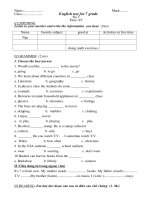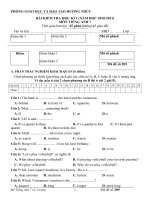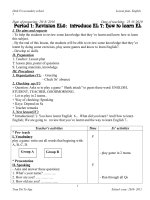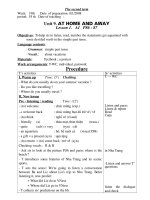GA Anh 7 Global 2223 HK 1
Bạn đang xem bản rút gọn của tài liệu. Xem và tải ngay bản đầy đủ của tài liệu tại đây (6.82 MB, 390 trang )
UNIT 1: HOBBIES
Lesson 1: Getting started – My favourite hobby
I. OBJECTIVES
By the end of this lesson, Ss will be able to gain:
1. Knowledge
- An overview about the topic Hobbies
- Vocabulary to talk about hobbies
2. Core competence
- Develop communication skills and creativity
- Be collaborative and supportive in pair work and teamwork
- Actively join in class activities
3. Personal qualities
- Love talking about their hobbies
II. MATERIALS
- Grade 7 textbook, Unit 1, Getting started
- Computer connected to the Internet
- Projector / TV/ pictures and cards
- sachmem.vn
Language analysis
Form
1. unusual (adj)
Pronunciation
/ʌnˈjuːʒuəl/
Meaning
different from what is usual or normal
Vietnamese equivalent
khác thường
2. creativity (n)
/ˌkriːeɪˈtɪvəti/
3. dollhouse (n)
4. cardboard (n)
5. glue (n)
6. making models
the ability to produce or use original and
unusual ideas
sự sáng tạo
/ˈdɒlhaʊs/
a toy that is a very small house, often
with furniture and small dolls in it
nhà búp bê
/ˈkɑːdbɔːd/
stiff material like very thick paper, often
used for making boxes
bìa các tơng
/ɡluː/
a sticky substance that is used for joining
things together
keo dán, hồ
making a representation of something,
usually on a smaller scale
làm mơ hình
/ˈmeɪkɪŋ ˈmɒdlz/
Assumption
Anticipated difficulties
Ss may lack experience of group / team work.
Solutions
Encourage Ss to work in groups so that they can help one another.
Give short, clear instructions, and help if necessary.
Board Plan
Date of teaching
Unit 1: Hobbies
Lesson 1: Getting started
*Warm-up
Asking questions
I. Vocabulary
1. unusual (adj)
2. creativity (n)
3. dollhouse (n)
4. cardboard (n)
5. glue (n)
6. making models
II. Practice
Task 1: Listen and read.
Task 2: Read the conversation again and write T (True) or F (False).
Task 3: Write the words and phrases from the box under the correct pictures. Then listen, check, and repeat.
Task 4: Work in pairs. Write the hobbies from 3 in the suitable columns.
III. Production
Task 5: Game: Find someone who…
*Homework
III. PROCEDURES
Notes:
In each activity, each step will be represented as following:
*
Deliver the task
**
Implement the task
***
****
Discuss
Give comments or feedback
Stage
WARM-UP
Stage aim
- To activate Ss’
knowledge on the topic
of the unit.
- To set the context for
the listening and reading
part.
- To enhance Ss’ skills of
cooperating with team
mates.
PRESENTATION - To provide Ss with
(VOCAB –
vocabulary.
PRE-TEACH)
- To help Ss well-prepared
for the listening and
reading tasks.
Procedure
Asking question:
* T asks Ss about what they like doing for pleasure in their free time.
What do you like doing in your free time?
Do you like collecting dolls?
Do you like collecting glass bottles?
Do you enjoy mountain climbing?
** Ss answer the question individually.
*** T sets the context for the listening and reading text: Write the title on
the board My favorite hobby.
**** Ask Ss to guess what the conversation might be about.
VOCABULARY
* Teacher introduces the vocabulary.
** Teacher explains the meaning of the new vocabulary by pictures.
1. unusual (adj)
2. creativity (n)
3. dollhouse (n)
4. cardboard (n)
5. glue (n)
6. making models
*** Teacher checks students’ understanding with the “Rub out and
remember” technique.
**** Teacher checks students’ pronunciation and gives feedback. Teacher
reveals that these four words will appear in the reading text and asks
students to open their textbook to discover further.
Interaction
T-Ss
Time
3 mins
S
T-Ss
T-Ss
T-Ss
T-Ss
T-Ss
T-Ss
3 mins
PRACTICE
To have Ss get to know the
topic.
TASK 1: LISTEN AND READ. (Ex 1, p. 8)
* Teacher asks Ss to look at the pictures in the book and answer the
questions:
+ What can you see in each picture?
+ What may the hobby be?
- Ss answer the questions in pairs.
** Teacher plays the recording twice. Ss listen and read.
*** Teacher checks Ss’ prediction. T calls 3 Ss to read the conversation
aloud.
**** Teacher check students’ pronunciation ad give feedback.
To have Ss get specific
information of the text.
TASK 2: READ THE CONVERSATION AGAIN AND WRITE TRUE (T) OR FALSE
(F). (Ex 2, p.9)
* Teacher tells Ss to read the conversation again and work independently
to find the answers. Remind Ss to underline the information and correct
the false statements.
** Ss work independently to find the answers.
4 mins
T-Ss
T-Ss
Ss
T-Ss
5 mins
T-Ss
Ss
*** Teacher has Ss compare the answers in pairs before checking with the
whole class.
**** Teacher checks the answers as a class and gives feedback.
Pair work
T-Ss
Answer key:
1. F (She made it herself.)
2. T
3. T
4. T
5. F (Her lesson starts at 8 a.m.)
To introduce some
vocabulary items related
to hobbies.
TASK 3: WRITE THE WORDS AND PHRASES FROM THE BOX UNDER THE
CORRECT PICTURES. THEN LISTEN, CHECK, AND REPEAT. (Ex 3, p. 9)
* T asks Ss to name the pictures.
** T has Ss work individually to match the words and phrases in the box
with the pictures. Have them compare their answers with a partner. Then
ask for Ss’ answers. Quickly write their answers on the board without
confirming the correct answers.
*** T has Ss listen to the recording, check their answers, and repeat the
words / phrases. Ask Ss to look at the answers on the board and say if they
are right or wrong. Confirm the correct answers.
**** Teacher checks the answers as a class and gives feedback.
Answer keys:
1. making models
4. gardening
8 mins
T-Ss
Ss
T-Ss
T-Ss
2. riding a horse
5. building dollhouses
3. collecting coins
6. collecting teddy bears
TASK 4: WORK IN PAIRS. WRITE THE HOBBIES FROM 3 IN THE SUITABLE
To give Ss a chance to
cooperate with others to
memorize the spelling of
hobbies.
PRODUCTION
To help Ss practise using
the vocabulary items
related to hobbies.
COLUMNS. (Ex 4, p.9)
* Have Ss work in pairs and complete the table.
** Ss work in pairs and complete the table.
*** Teacher allows students to share answers before discussing as a class.
**** Write their answers on the board. Have Ss add more words to the
table.
Answer key:
+ doing things: riding a horse, gardening (others: travelling, skiing, doing
yoga, etc.)
+ making things: making models, building dollhouses (others: painting,
making pottery, etc.)
+ collecting things: collecting coins, collecting teddy bears (others:
collecting toys, collecting books,etc.)
TASK 5: GAME: FIND SOMEONE WHO… (Ex 5, p.9)
Work in groups. Ask as many classmates as you can about which hobbies
they like. Use the question ‘Do you like…?’.
In the table below, write your classmates’ names beside the activities
they like.
* T lets Ss to move around the class to ask their classmates about their
favourite hobbies in 3-5 minutes.
** Ss write the results into the table.
*** Then T asks some Ss to report their results. Whoever has the most
names wins.
**** Teacher can ask students to read aloud the full sentences and correct
their pronunciation if needed.
5 mins
T-Ss
Pair work
T-Ss
T-Ss
11 mins
Ss-Ss
Ss
T-Ss
T-Ss
WRAP-UP
To consolidate what Ss
have learnt in the lesson.
T asks Ss to talk about what they have learnt in the lesson.
- An overview about the topic Hobbies
- Vocabulary to talk about hobbies
T-Ss
2 mins
HOMEWORK
To review the lesson and
prepare for the next
lesson.
- Name a list of cheap hobbies, expensive hobbies, easy and difficult
hobbies.
- Do exercises in the workbook.
- Prepare for Lesson 2 - A closer look 1
- Start preparing for the Project of the unit.
Teacher randomly puts Ss in groups of 4 or 5 and asks them to choose a
popular hobby among teens and think about its benefits, then discuss to
choose what to include. They have to find suitable photos or draw pictures
then creat a poster about it. Students will show their posters and present
their ideas in Lesson 7 – Looking back and Project. (Teacher should check
the progress of students’ preparation after each lesson.)
T-Ss
2 mins
UNIT 1: HOBBIES
Lesson 2: A closer look 1
I. OBJECTIVES
By the end of this lesson, students will be able to gain:
1. Knowledge:
- Vocabulary:
+ The lexical items related to hobbies
+ Verbs of liking and disliking
- Pronunciation: Correctly pronounce words that contain the sounds /ə/ and /ɜ:/
2. Core competence
- Develop communication skills and creativity
- Be collaborative and supportive in pair work and teamwork
- Actively join in class activities
3. Personal qualities
- Love talking about their hobbies
- Develop self-study skills
II. MATERIALS
- Grade 7 textbook, Unit 1, Getting started
- Computer connected to the Internet
- Projector / TV/ pictures and cards
- sachmem.vn
Language analysis
Form
1. jogging (n)
2. coin (n)
Pronunciation
Meaning
Vietnamese equivalent
/ˈdʒɒɡɪŋ /
the activity of running at a slow, regular speed,
especially as a form of exercise
đi / chạy bộ thư giãn
/kɔɪn/
a small, round piece of metal, usually silver or
copper coloured, that is used as money
đồng xu
Assumptions
Anticipated difficulties
1. Students may lack experience of group/ team work.
Solutions
- Encourage students to work in groups so that they can help
each other.
2. Students may not have sufficient listening, speaking
and co-operating skills.
Play the recording, the replay depends on the
students’ need and level.
- Encourage students to work in pairs, in groups
so that they can help each other.
- Provide feedback and help if necessary.
-
Board Plan
Date of teaching
Unit 1: HOBBIES
Lesson 2: A closer look 1
*Warm-up
Asking questions
I. Vocabulary
1. jogging (n)
2. coin (n)
Task 1: Complete the word webs.
Task 2: Complete the sentences, using the –ing form of the verbs from the box.
Task 3: Look and say the sentences. Use suitable verb of liking or disliking and the –ing form.
II. Pronunciation
Task 4: Listen and repeat.
Task 5: Listen to the sentences. Tick (✓) the appropriate sounds. Practise the sentences.
III. Production
Game: Who is faster?
*Homework
III. PROCEDURES
Notes:
In each activity, each step will be represented as following:
*
Deliver the task
**
Implement the task
***
Discuss
**** Give comments or feedback
Stage
WARM-UP
LEAD-IN
VOCABULARY
Stage aim
- To create an active
atmosphere in the class
before the lesson.
- To lead into the new
lesson.
To introduce the new
words.
To present some action
verbs that go with
nouns to describe
hobbies.
Procedure
WARM-UP: ASKING QUESTION:
* Teacher asks students some questions about the hobbies:
1. What is your favorite hobby?
2. When did you start your hobby?
** Some students are invited to answer.
*** Teacher and students discuss the answers.
**** Teacher introduces the lesson.
VOCABULARY:
* Teacher introduces the vocabulary.
** Teacher introduces the vocabulary by:
- providing the pictures
- providing the definition of the words.
1. jogging (n)
2. coin (n)
*** Teacher asks students to repeat.
*** Teacher checks students’ understanding with the “Rub out and
remember” technique.
TASK 1: COMPLETE THE WORD WEBS BELOW WITH THE WORDS FROM
THE BOX. (Ex 1, p. 10)
* Teacher has students read the action verbs and match them with suitable
words the box. Remind them that a verb can go with more than one word.
** Teacher asks students to work in pairs and quickly do the task.
*** Teacher allows students to peer check first.
**** Teacher checks and confirms the answers. Then have students add
more words that can go with these action verbs.
**** Have students read the Remember! box. Ask them to make some
Interaction
Time
7 mins
T-Ss
Ss
T-Ss
T-Ss
T-Ss
T-Ss
T-Ss
T-Ss
T-Ss
T-Ss
Pair work
T-Ss
T-Ss
15 mins
examples with the verbs of liking and disliking.
Answer key:
go: jogging, swimming (others: go camping, go fishing, go cycling, etc.)
do: judo, yoga (others: do karate, do exercise, do sit-ups, etc.)
collect: dolls, coins (others: collect books, collect watches, collect pencils,
etc.)
To help students
practise the verbs of
liking / disliking and
action verbs.
TASK 2: COMPLETE THE SENTENCES, USING THE –ING FORM OF THE
VERBS FROM THE BOX. (Ex 2, p. 10)
* Teacher reminds students about the form of verbs of liking / disliking.
** Have students do this activity individually. Have students read all the
sentences carefully to make sure they understand the sentences.
*** Teacher lets them share their answers in pairs. Invite some students to
give the answers.
**** Teacher writes the correct answers on the board.
Answer key:
1. collecting
To give further practice
with verbs of liking /
disliking.
2. going
3. playing
4. making
T-Ss
Ss
Pair work
T-Ss
5. doing
TASK 3: LOOK AT THE PICTURES AND SAY THE SENTENCES. USE SUITABLE
VERB OF LIKING OR DISLIKING AND THE –ING FORM. (Ex 3, p. 10)
* Teacher has students look at the pictures in this exercise and say what
the person / people is / are doing in each picture.
- Ask them what the face in each picture means. (A sad face means ‘not
like’ and a happy face means ‘like’.)
- Ask students to look at the example to make sure they understand what
to do.
T-Ss
** Teacher asks students to work in pairs to make sentences.
*** Teacher invites students to share their answers.
**** Confirm the correct answers.
PRONUNCIATION
- To help students
identify how to
pronounce the
sounds /ə/ and /ɜ:/.
- To help students
practise pronouncing
these sounds in words.
Answer key:
1. He hates / doesn’t like doing judo.
2. They like / love / enjoy playing football.
3. They love / like / enjoy gardening.
4. They enjoy / like / love collecting stamps.
5. She hates / doesn’t like riding a horse / horse riding.
TASK 4: LISTEN AND REPEAT. PAY ATTENTION TO THE SOUNDS /Ə/
AND /ɜ:/. (Ex 4, p. 11)
* Teacher has some students read out the words first.
- Teacher plays the recording for them to listen and repeat the words they
hear. Ask them to pay close attention to the two sounds. Play the recording
as many times as necessary.
** Teacher explains to students the difference between the two sounds if
needed. Tell students that /ə/ is the schwa sound while /ɜ:/ sounds like it
has a soft /r/ in it.
*** Teacher invites some students to say some words they know that
include the two sounds.
**** Confirm the correct answers.
Pair work
T-Ss
T-Ss
13 mins
T-Ss
T-Ss
T-Ss
T-Ss
(Teacher can play the pronunciation guide video of this unit for students to
watch and learn).
To help students
pronounce the
TASK 5: LISTEN TO THE SENTENCES AND PAY ATTENTION TO THE
UNDERLINED PARTS. TICK (✓) THE APPROPRIATE SOUNDS. PRACTISE THE
T-Ss
T-Ss
sounds /ə/ and /ɜ:/
correctly in sentences.
SENTENCES. (Ex 5, p. 11)
* Teacher has students quickly read the sentences.
** Teacher plays the recording for students to listen to the sentences. Ask
them to pay attention to the underlined parts and tick the appropriate
sounds.
*** Invite some students to share their answers.
**** Confirm the correct ones.
Ss
T-Ss
Answer key:
1. My hobby is collecting dolls.
2. I go jogging every Thursday.
3. My cousin likes getting up early.
4. My best friend has thirty pens.
5. Nam enjoys playing the violin.
PRODUCTION
/ə/
✔
/ɜ:/
✔
✔
✔
✔
To test students' quick
GAME: WHO IS FASTER?
reaction to the targeted * Teacher divides students into groups of four, gives each group a piece of
sounds.
paper, asks them to write sentences including: hobbie(s) and one of the
sounds /ə/ and /ɜ:/.
- (e.g: Listening to music is a very common hobby.)
** Students play the game.
*** Teacher asks each group to hand in their papers and checks, the group
with the most correct sentences is the winner. Teacher invites the winner
to read aloud their sentences.
**** Teacher gives feedback.
T-Ss
Group work
T-Ss
T-Ss
7 mins
WRAP-UP
HOMEWORK
To consolidate what
students have learnt in
the lesson.
Teacher asks students to talk about what they have learnt in the lesson.
T-Ss
2 mins
To reactivate the
knowledge that
students have gained
Find 3 more words relating to hobbies that have the sounds /ə/ and /ɜ:/.
T-Ss
1 min
UNIT 1: HOBBIES
Lesson 3: A closer look 2
I. OBJECTIVES
By the end of this lesson, Ss will be able to:
1. Knowledge
- Review the knowledge on present simple tense
2. Core competence
- Develop communication skills
- Be collaborative and supportive in pair work and team work
- Actively join in class activities
3. Personal qualities
- Be encouraged to know more about their classmate’s hobbies
- Develop self-study skills
II. MATERIALS
- Grade 7 textbook, Unit 1, A closer look 2
- Computer connected to the internet
- Projector/ TV/ pictures and cards
- sachmem.vn
Language analysis
Form
Present simple tense
Example
S + Vinf/ V(s/es) + …
I usually collect bottles after use.
S + don’t/ doesn’t + Vinf + …
She doesn’t like swimming.
Do/ Does + S + Vinf + …?
Do you like playing board games?
W/H + do/does + S + Vinf + …?
What do you often do when you have free time?
Assumptions
Anticipated difficulties
Solutions
1. Ss may not remember the forms of present simple tense.
Remind them quickly the forms and use of each tense.
2. Ss may not have sufficient speaking and co-operating
skills.
Give clear instructions, give examples before letting Ss work
in groups.
Provide feedback and help if necessary.
Board Plan
Date of teaching
Unit 1: Hobbies
Lesson 3: A closer look 2
*Warm-up
Game: Guessing game
I. Grammar focus
Present simple tense: Review
II. Practice
Task 1: Match the sentences (1 – 5) to the correct uses (a – c).
Task 2: Complete the sentences. Use the present simple form of the verbs.
Task 3: Fill in each blank with the correct form of the verb in brackets.
Task 4: Write complete sentences, using the given words and phrases.
You may have to change the words or add some.
III. Production
Task 5: Game: Sentence race
*Homework
III. PROCEDURES
Notes:
In each activity, each step will be represented as following:
*
Deliver the task
**
Implement the task
***
Discuss
**** Give comments or feedback
Stage
Stage aim
Procedure
WARM-UP
- To review some hobbies.
- To increase Ss’ interest.
- To enhance Ss’ skills of
cooperating with
teammates.
Game: Guessing game
* T divides the class into 4 teams.
** T calls on a S from each team to go to the board in turn. That S thinks of
a hobby and says the keywords out loud.
The other teams try to guess What the hobby is. They will get 1 point for
each correct answer. The team with the most points is the winner.
*** Teacher and students discuss as a class.
**** Teacher asks students to say the words aloud and makes sure they
pronounce the words correctly. Teacher can ask for translation to check
their understanding.
Interaction
Time
5 mins
T-Ss
Group work
T-Ss
T-Ss
Example:
A: water, grow, flowers, vegetable.
B: Is it gardening?
A: Yes, it is.
LEAD-IN
To introduce the targeted
grammar.
PRESENTATION To review the present
simple tense.
T draws Ss’ attention to the form of the sentences created in the game and
asks them whether they know the target tense.
THE PRESENT SIMPLE: REVIEW
* T has the Ss review the forms and use of present simple before doing the
exercises.
** Ss retell the form and the uses of the tense: The present simple.
*** T comments and explains again.
- T shows each of the examples in the Remember box on the slide or have
Ss read the examples in the book. T highlights the present simple form.
T-Ss
2 mins
4 mins
T-Ss
Ss
T-Ss
Explain each use.
- T has Ss read the orange box in the book again to help them understand
better the uses of the present simple.
- T asks Ss what signal words help them identify the verb tense. Elicit
answers from Ss. (Signal words are adverbs of frequency and verbs such as
start, etc.)
**** Teacher checks their answers as a class.
PRACTICE
To help Ss identify and
remember the uses of the
present simple.
TASK 1: MATCH THE SENTENCES (1 – 5) TO THE CORRECT USES (A – C).
(Ex 1, p. 11)
* T asks Ss to do the exercise individually and then check their answers in
pairs.
** Ss do the exercise individually.
*** T invites some Ss to share their answers.
**** Confirm the correct answers.
Answer key:
1. b
2. a
3. c
4. a
5. b
To help Ss practise the
TASK 2: COMPLETE THE SENTENCES. USE THE PRESENT SIMPLE FORM OF
correct form of the present THE VERBS. (Ex 2, p. 12)
simple.
* T has Ss do this exercise individually and then compare their answers
with a partner.
** T asks some Ss to write their answers on the board.
*** T checks the answers with the whole class. Ask Ss to explain the use of
the tense in each sentence.
**** T confirms the correct answers.
Answer key:
T-Ss
22 mins
T-Ss
Ss
T-Ss
T-Ss
Ss-Ss
Ss
T-Ss
T-Ss
1. make
4. doesn’t like
To give further practice
with the present simple
2. does … do
5. Does … start
TASK 3: FILL IN EACH BLANK WITH THE CORRECT FORM OF THE VERB IN
BRACKETS. (Ex 3, p. 12)
* T has Ss do this exercise in pairs and then compare the answers with
another pair.
** T asks some Ss to write their answers on the board.
*** T checks the answers with the whole class. T asks Ss to explain the use
of the tense in each sentence.
**** T confirms the correct answers.
Answer keys:
1. enjoys
2. spends
4. go
5. begins
To give further practice
with the present simple.
3. have
Pair work
T-Ss
T-Ss
T-Ss
3. don’t like / do not like
6. don’t enjoy / do not enjoy
TASK 4: WRITE COMPLETE SENTENCES, USING THE GIVEN WORDS AND
PHRASES. YOU MAY HAVE TO CHANGE THE WORDS OR ADD SOME. (Ex 4,
p. 12)
* T has Ss work in groups to write the sentences. Give each group a
T-Ss
large-size sheet of paper to write.
** Ss work in groups to write the sentences.
Group work
*** T has groups cross-check.
Group work
**** T sticks some sheets on the board. Comment and confirm the correct
T-Ss
answers.
Answer key:
1. The sun sets in the west every evening.
2. Do Trang and Minh play basketball every day after school?
3. The flight from Ho Chi Minh City doesn’t arrive at 10:30.
4. Our science teacher starts our lessons at 1 p.m. on Fridays.
5. Do you make models at the weekend / at weekends?
PRODUCTION
- To give Ss a chance to
apply what they have
learnt.
- To improve cooperative
skill.
TASK 5: GAME: SENTENCE RACE (Ex 5, p. 12)
T-Ss
* T divides Ss into groups. Assign a group leader.
- T writes a verb on the board and have Ss make a sentence with the verb,
using the present simple form.
Group work
** The group leader records his / her group’s points.
T-Ss
*** T invites group leaders to read aloud the sentences.
T-Ss
**** T comments and announces the winners.
7 mins
WRAP-UP
To consolidate what Ss
have learnt in the lesson.
T asks Ss to talk about what they have learnt in the lesson.
T-Ss
3 mins
T-Ss
1 min
HOMEWORK
To reactivate & consolidate
- Make 3 sentences in the present simple tense.
- Complete the exercises in the Workbook.
the knowledge learnt in
the lesson.
UNIT 1: HOBBIES
Lesson 4: Communication
I. OBJECTIVES
By the end of this lesson, Ss will be able to describe and give opinions about hobbies.
1. Knowledge
- Use the lexical items related to the topic Hobbies
- Talk about likes and dislikes
- Ask and answer about hobbies.
2. Core competence
- Develop creativity and communication skills
- Be collaborative and supportive in pair work and team work
- Actively join in class activities
3. Personal qualities
- Be ready to describe and give opinions about hobbies.
- Be interested more about new hobbies.
II. MATERIALS
- Grade 7 textbook, Unit 1, Communication
- Computer connected to the internet
- Projector/ TV/ pictures and cards
- sachmem.vn
Assumptions
Anticipated difficulties
Solutions
1. Ss may not have sufficient listening skills.
- Play the recording many times if necessary.
- Pick some Ss ask and answer the questions.
- Have Ss practise the dialogue in pairs.
2. Some Ss may excessively talk in the class.
- Define expectation in explicit detail.
- Give some examples with these verbs.
- Model asking and answering with a student.
Board Plan
Date of teaching
Unit 1: Hobbies
Lesson 4: Communication
*Warm-up
Game: Arrange the following verbs of liking in descending order of preference.
I. Everyday English
Verbs of liking
Task 1: Listen and read the dialogue below. Pay attention to the questions and answers.
Task 2: Work in pairs. Ask and answer questions about what you like and don’t like doing.
II. All about your hobbies
Task 3: Answer the questions. Fill in column a with your answers.
Task 4: Now interview your friend, using the questions in Task 3. Write his / her answers in column B.
Task 5: Compare your answers with your friend’s. Then present them to the class.
*Homework









